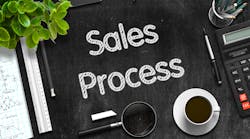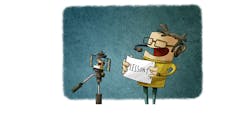So far in this series we have reviewed the geographic salesperson, functional salesperson and introduced the three models of tomorrow's sales force: transactional, consultative (service product) and enterprise. In this installment, we review the necessary ingredients for the transactional model and channel configurations for successful growth.
What is the Transactional Model? The transactional model is the low-cost model of distribution. In essence, the transactional model attempts to let the customer order products without the aid of salespeople.
Note the distinction between salespeople and customer service representatives. Salespeople are outside or inside representatives who are knowledgeable of the products, their application and buyer characteristics. Customer service representatives can field general questions and help with service problems regarding shipments, account balances and pricing discrepancies, but they are not product, application, or customer-service experts like salespeople.
The transactional model assumes economic buyers who want reasonable service at a low price. Integral to the transactional model is a front-door design that gives the customer product and service information without a sales force. For this reason, transactional distributors need to have a robust catalog or e-commerce model to accompany the strategy.
The transactional model resembles Figure 1. In the transactional model, all of the functions/services are driven around a low cost with predictable service. Looking at the figure, product selection is low with purchasing narrowing vendors to buy at the highest volume and lowest price. Brand names may be used for some products, but suppliers are encouraged to help the distributor take the cost out wherever possible.
Like product selection, delivery, payment options and warehousing minimize exceptions and essentially have a “one-size-fits-all” service promise. Customer service is dominated by personnel who can answer basic questions on order, payment and warranty/return options. Customer service is strictly an inbound function with customers communicating primarily by phone on service issues.
The ordering process is made easier by robust content with product pictures and limited engineering data/schematics in a paper catalog or on the Internet. Integral to the transactional model is the willingness of the customer to pay a low price and accept less service than a full-service distributor would provide. In effect, the customer internalizes the costs provided by a full-service distributor in exchange for a low price from the transactional distributor. The primary driver behind the model is the ability of the customer to place orders directly to the distributor with as little sales assistance as possible.
Although the transactional model of wholesaling is not the dominant method of commerce, it will have a bright future if acceptance of e-commerce and e-business increases. To understand the power of the transactional model, look at catalog houses in industrial products. In essence, the catalog house has many of the elements of Figure 1 including limited delivery options, highly automated warehousing, limited sales assistance to ordering and a streamlined ordering process. Most catalog houses net between 8 percent and 12 percent pre-tax compared to the average traditional distributors' 2 percent to 3 percent.
Of course, the functional area that will be reduced in the transactional model is the sales force. If inside and outside sales costs 8 percent of sales revenue, the sales force costs 40 percent of total operating expenses (8 percent divided by the 20 percent typically attributed to operating expenses).
Downsizing the sales force is often disturbing to the traditional distributor. Most distribution owners and top managers detest parting with their salespeople. In their eyes, the salespeople are the reason they exist. In short, the salespeople established relationships and solicited the customers the company is built upon.
Although this thinking is correct, as industries mature there are economic buyers who don't want and aren't willing to pay for full-service offerings. If transactional models are to appear from the established, full-service distributors, management will have to change its view of the sales function. Understanding how the customer values salespeople and how to begin moving salespeople away from economic buyers is discussed in the next section.
How many salespeople do we need? Far too often, I find that distributors don't ask the critical question, “How many salespeople do I need?” They experiment with the salespeople, trying any number of configurations to deploy them for a greater return. Most sales deployment is done around internal data and reconfigurations of the existing sales force.
One of the most-used sales allocation methods is the ABC account analysis, which groups accounts by the most important (A) to the least important (C). A call frequency is given for the outside salesperson for each account, and the accounts are rolled up to deliver a territory that “needs” 1,000 to 1,200 calls per year.
The functional or product/market is another method of allocation. It groups salespeople by product technology or market segment. For instance, salespeople could be allocated by commercial vs. residential contractors (customer segment) or commercial lighting vs. telecommunications (product expertise). The functional or market segment sales allocation is generally superior to the geographic-allocated sales force.
Some distributors divide salespeople by their comfort zones (personal expertise). As a result, monikers such as hunters, farmers and relationship salespeople have found a place in the jargon of sales management. (For a review of functional or comfort-zone allocations, please see any number of sales-management texts or the initial article of this series, which appeared on page 38 of the April 2001 issue.)
The problem with these allocation methods is that the customer is never asked, “How often do you want to see our salespeople?” or, “How do the salespeople contribute to your overall satisfaction?” In 20 years of dealing in wholesale markets, I can count on one hand the number of sales and executive managers who asked their customers these questions with valid statistical research.
Most sales managers assume the customer wants to see outside salespeople and hear from inside salespeople. For most sales managers, the idea of reducing the sales force as a competitive cost advantage is seen as a curtailment of their power.
To understand how many salespeople a distributor needs and how the salespeople contribute to customer satisfaction, I recommend two research methods.
Using derived satisfaction and call frequency polling for sales deployment. It is imperative to include customer input in the sales equation. Customers should be the final arbiters of the value they ascertain in the sales process. Far too often, distribution managers don't give customers meaningful choices of how, how much, and when they want or need salespeople.
The model I propose gauges two fundamental levels of customer input: 1) How often do customers want to see salespeople? 2) How do the salespersons' services contribute to your overall service satisfaction? I will start with the second question and end with the first.
Service satisfaction and loyalty are integral measurements to the future of wholesaling. If you buy the argument that distributors sell mainly commodity goods and don't control the physical features/benefits of their products, then the fundamental way they add value is through services. Ascertaining service value is more than simply conjuring up value addeds and saying you produce them. Good, solid measurement of service value needs to be done to manage service offerings.
A previous article on fee-based services (May 2000, p. 36) provides information on satisfaction research as a tool for measuring service satisfaction. Distributors have yet to fully adopt service measurement, but the drubbing they give each other for 2 percent pre-tax because they don't define their unique service value is growing tiresome. Solid service management is on the horizon for those tired of the old way of business.
Figure 2 on page 32 gives a standard Attribute Report on service satisfaction. There are 17 service variables measured for the sponsor and competitive distributors. Notice the first two columns named Derived Importance Ranking and R-Square. The term Derived Importance is literal since the attributes are derived and ranked by their R-Square score. The R-Square is an output of a mathematical process called Linear Regression. In the process, each service variable is measured on how it influences overall satisfaction. The highest R-Square score has the most predictive influence on overall satisfaction; hence, the ranked importance of each variable is derived.
The results in Figure 2 are fairly indicative of research gathered over the past 10 years on distributors' service offerings. Almost always, the variables for outside salespeople are the least influential on overall customer satisfaction. Of course, these variables can change by segment, but the point is clear. Outside selling is, in general, not as important to the existing customer's service satisfaction as other variables. Distribution management, ostensibly, doesn't recognize this since they typically pay outside salespeople more than inside salespeople and throw outside salespeople at all buying situations.
Many distributors over serve with outside salespeople who are typically the most expensive part of the marketing mix. This observation also leaves room for transactional models of distribution, among others. In short, my experience with valid statistical research on service management leads me to believe that sales-intensive models of distribution are driven more by management's unwillingness to experiment with new methods of business than the existing customer's requirement to see a salesperson. If this does not wash on the palette of sales managers and convince them, then perhaps the next analysis will.
Call-frequency polling is a simple, straightforward method of determining the customer's need for call frequency. In a written survey, simply ask the customer the following:
“How often do you need ABC Electric's outside salespeople to call on you?”
A. Once per week
B. Once every two weeks
C. Once per month
D. Once per quarter
E. Once every six months
F. Once per year
G. I don't want a sales person to call on me.
Give this survey to the 20/80 customers and those with potential from the territorial sales plan. Also, concurrently give the survey to the outside salesperson. Once both sets of surveys are back, compare the customers' results to those of the outside salesperson. My observations using this simple analysis are that customers say they want to see salespeople a full 30 percent to 40 percent less than salespeople actually see them. Understand that the analysis is simplistic and you will get varying answers from different size customers.
Customer polling of sales-call frequency can be done for a small fee. The results are often eye opening. If a distributor carries 30 percent to 40 percent excess sales capacity, the cost of the unwanted service is 40 percent of 3 percent cost or 1.2 percent. This is fully 50 percent of the average pre-tax margin of contractor-based distributors!
Conducting satisfaction research and customer polling of call frequency is only a start in changing the model of wholesaling. The transactional model requires great planning and a fundamental change in the way of business. It is often better to house a transactional service in a separate branch with different management and a different business plan than simply offering it to the customer as a part of the normal service offering. The future of the transactional model rests on the ability of executives to develop a different way of thinking about the business and engendering a low cost/predictable service model. And, integral to the new way of business is conforming the pricing file to reflect reduced service offerings.
Pricing strategy and service offering. I recently had a conversation with an industry insider about why so many dot-coms failed in traditional distribution markets. The unreasonable attempt to separate product knowledge from order fulfillment, exchanges that lengthened the channel instead of shortening it, and a failure to lower pricing commensurate with a lessened service offering were among the answers.
A successful transactional model depends on several factors including the ability to take cost out using technology, the ability to provide consistent basic service, and inducing volume with a low price sustained from a low cost of operations. The level of price needed to induce customers to support a new model of business varies with the level of service.
Fundamentally speaking, if you reduce services including robust sales support and service variety, price will need to fall. If the sales force expenses of inside and outside run 8 percent of sales and are replaced with customer service representatives and e-commerce that cost 4 percent of sales, the math says that the customers should get a 4 percent better price (8 percent minus 4 percent). Industrial markets and their services seldom are black and white; the answer will be gained more by trial and error than cost justifications.
I believe transactional models are just around the corner. I also believe that they will heavily involve e-commerce, new management paradigms, and the best will spring from current distributors tired of earning 2 percent pre-tax year after year.
Scott Benfield is a consultant on marketing and sales strategy for distribution. He can be reached via phone at (630) 428-9311 or via e-mail at [email protected].
Figure 1
Figure 2
Importance
Ranking
Percent







